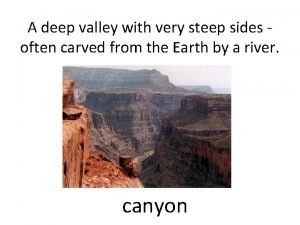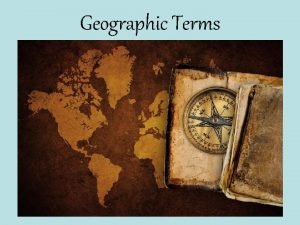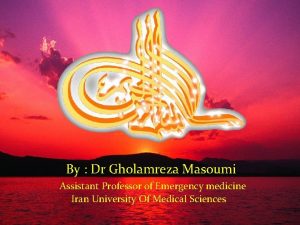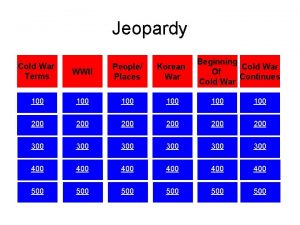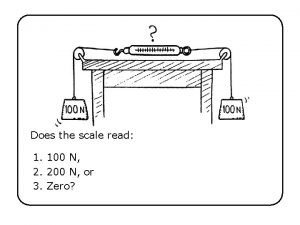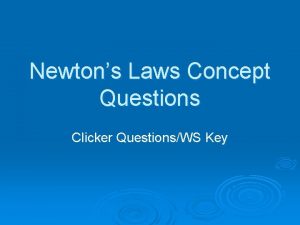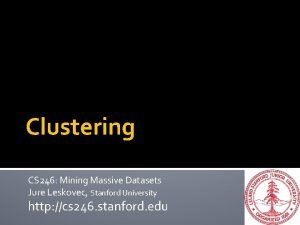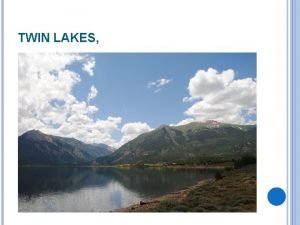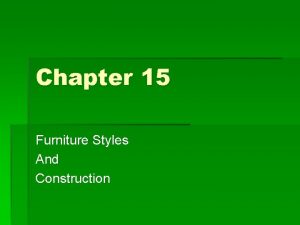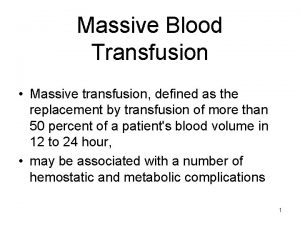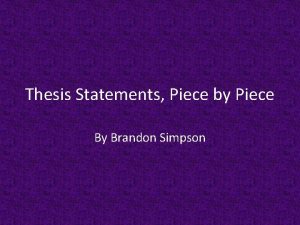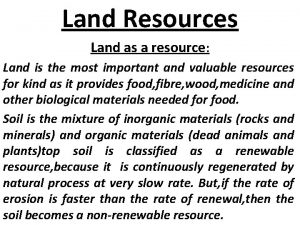India India is a massive piece of land






























- Slides: 30

India

• India is a massive piece of land with very different climates, agriculture, and regions • In the north – the Indus river valley - agriculture is made possible by rivers flowing from the Himalayas • Around 3, 000 B. C. E. the Dravidians settled the Indus river valley and built complex societies • There were two major centers: a) Harappa b) Mohenjo-daro • Both cities had walls, market places, temples, residential buildings constructed in a grid

• Harappa depended upon agriculture, but also traded • The wealthy members of society lived in very ornate and luxurious houses with bathrooms and a sewer system • Both societies practiced polytheism and most of the gods were associated with nature • Around 1, 900 B. C. E. the Harappan society started to decline – no one is quite sure why • By 1, 500 B. C. E. Harappa and Mohenjaro-daro had all but disappeared

Aryans • As the Harappa society decline bands of nomads who had migrated south settled in the Indus river valley • They were pastoralists and spoke an Indo. European dialect • They were called Aryans • Over several hundred years the Aryans moved into northern India • They came into conflict with the Dravidians who also lived in the area • Eventually both groups inter-married

• The Aryans used an oral tradition to pass on their history • These stories were called Vedas – collections of hymns, poems, and prayers • There were four Vedas, but the most important was the Rig- Vedas • Historians have called this period the Vedic age • The Aryans were polytheistic and many of their gods reflected the violent nature of their society • The Aryans often attacked each other as well as the Dravidians • The towns were independent – there was no central government

• Between 1, 000 and 500 B. C. E. the Aryans settled down and established small states with political systems • Their political system was build around an hierarchical social order • Place in society was hereditary and this became the foundation of the caste system • The Aryans called the social classes varna, and there were four main varna a. brahmins – priests b. kshatriyas – warriors or aristocrats c. vaishyas – merchants or artisans d. shudras – landless peasants or serfs

• Much later they added another category – the untouchables • Untouchables performed undesirable jobs • The rules for the social order were called jati and the jati dictated what a person could or could not do • The Aryans created a patriarchal society with men controlling all the important positions – women were responsible for the house

Religion • The Aryans were polytheistic, their chief god was Indra, a god of war • The Aryans offered sacrifices to their gods and these sacrifices developed into elaborate ceremonies and rituals • Gradually the people grew dissatisfied with their religion • A group of Aryans formed a community in the Ganges valley to contemplate the meaning of life and the Vedas

• The Dravidians had believed that a spirit returns in another body after death • The Aryans developed this idea and mixed it with their own beliefs to create a new religious philosophy • Around 400 B. C. E. were written in the Upanishads • The Upanishads said that the soul was continually reborn and they placed a great deal of importance upon a person living an ethical life

Mauryan Dynasty • About 520 B. C. E the Persian emperor Darius crossed the Hindu Kush and entered India • He created the kingdom of Gandhara and introduced the Persian system of administrating • In 327 B. C. E. Alexander the Great crossed the Hindu Kush, but was forced to leave when his men mutinied • After Alexander left Chandragupta Maurya started combining the small provinces and consolidating his power • Within a short time he controlled all of northern India

• Chandragupta's chief advisor, Kautalya, wrote down instruction on how to administer the state • These writing are called Arthashastra • When Chandragupta’s grandson Ashoka became empire he was able to extend the empire even further • Ashoka proved good ruler, however he was fortunate to have inherited a large and stable bureaucracy • In 260 B. C. E. he adopted Buddhism • He encouraged agriculture, created irrigation systems and built roads to facilitate trade • However almost as soon as he was dead the empire started to fall apart

Gupta Dynasty • Over the next two centuries various people tried to establish new dynasties in India • The next successful dynasty was the Gupta dynasty • Chandra Gupta created alliances with regional rulers in the Ganges river basin • Gradually he was able to assert control and eventually rule an area that covered most of northern India • They left the decision-making to local officials rather than forcing their authority on others

• But as soon as the empire was threatened it broke apart because there was no central administration • Eventually the Gupta were confronted by the Huns who had migrated from central Asia • Initially the Guptas were able to stop the Huns but eventually the Huns moved across the empire at will

Buddhism • Siddhartha Gautama was the founder of Buddhism • He was born into a fairly wealthy family in roughly 560 B. C. E. • He grew dissatisfied with his lifestyle and set out to find the origin of suffering • At first he meditated but this did not work • According to legend he determined to sit under a bo tree in Bodh Gaya until he understood the meaning of suffering

• After 49 days he became enlightened and realized what humans must do to remove suffering from their lives • Gautama became Buddha – “Enlightened one” • He delivered sermons to his friends and soon attracted disciples from across the region • Buddhism is based on Four Noble Truths, and by living a life according to the Noble Eightfold Path • Humans should reject the luxuries and excesses of life and follow dharma – the doctrine of Buddhism • Personal salvation would allow them to leave the cycle of reincarnation and achieve nirvana – spiritual independence

Hinduism • The doctrine of Hinduism can be found in a poem called Bhagavad Gita • The Gita promised salvation to all classes if they lived honorable lives – unlike the Upanishads • Slowly Hinduism became the most popular religion in India because it was more appealing to the masses • Buddhists tended to avoid the masses and stay in their monasteries contemplating, while Hindus went out among the people

Harsha • After the fall of the Gupta dynasty northern India became a battleground for nomadic groups who had migrated south • King Harsha restored some semblance of centralized authority at the start of the seventh century • Once in control Harsha proved to be a very compassionate ruler • He was a Buddhist but tolerated other religions • He built hospitals and reported distributed his own wealth to the poor

• Regardless of his personal qualities he was not able to stop the decline that had been set in motion • When he was assassinated the empire fell into immediate decline • The new invaders brought with them a new religion – Islam • Merchants took valuable products from India to Asia and Europe and brought back new ideas and philosophies • Muslim traders became an important part of the commercial sphere in India

• Mahmud of Ghazni, from Afghanistan, moved his men south • Mahmud did not want to control he wanted to plunder, especially the beautiful temples • They destroyed Hindu and Buddhist temples and built mosques • By the thirteenth century most of northern India was under Muslim control, while the south remained mostly Hindu • The Sultanate of Delhi was established, with the capital at Delhi • Many Hindus converted to Islam in hopes of ending discrimination

The Age of Exploration • In 1488 Bartolomeu Dias rounded the cape of Good Hope and entered the Indian Ocean • In 1498 Vasco de Gama arrived at Calicut • Europeans were looking for a way to take advantage of the lucrative spice and silk trade between Europe and Asia • Traditionally traders would travel overland but that was costly, time-consuming, and dangerous • What they needed was sea route to Asia • When Columbus arrived in the New World he was searching for the Indies

The Mughal Empire • In 1523 Zahir al-Din Muhammad, also known as Babur arrived in northern India • In 1526 he captured Delhi and founded a dynasty called the Mughal • Babur had little interest in building an empire, but he certainly valued the wealth of India • Babur’s grandson, Akbar extended the empire to the south • The most famous Mughal legacy is the Taj Mahal

The British • British interest in India was through the British East India Company who obtained permission for the Mughal emperors to build fortifications along the coast • When the Mughal declined the East India Company moved forward to take advantage of the situation • So powerful were the East India Company that they used the British army and some Indians troops (sepoys) to enforce their laws

• In 1857 the sepoy rebelled and killed the British officers • Local people joined the rebellion and proclaimed a new Mughal dynasty • The British were better equipped and technological advanced • With the telegram they were able to order more reinforcements • At Lucknow the sepoy massacred all the British people including women and children • When the British gained control they punished the mutineers by blowing them to bits

• In 1858 the British government took direct control of India to stop any more bloodshed • The government was represented by a viceroy who was answerable to Parliament • The viceroy appointed English people to the best positions in the country • The British cleared the jungle, planted crops, built railroads and schools. They constructed canals and created a telegram network to bring India into the twentieth century • Everything the British did was based on the English model

• The children of the wealthy Indians were sent to English schools to learn to be good administrators • The British were tolerant of other religions and did not try to force Christianity upon the Indians • The English did stop the practice of sati – the burning of a widow on her husband’s funeral pyre

Independence • In 1885 the Indian National Congress was founded to unite Hindus and Muslims in an attempt to gain self-rule • In 1906 the Muslim League was formed to ensure that the Muslims would always have a voice and not simply replace British rule with Hindu rule • During World War I Indians of all religions helped Britain against the Central Powers • But after the war they became familiar with Woodrow Wilson’s call for self-determination and Lenin’s call for the freedom of the colonized

Mohandas Gandhi • Gandhi was Hindu who had grown up in a wealthy household, married when he was thirteen, and gone to London to study law • After London he went to South Africa to work for an Indian firm and became invloved in racial issues • He adopted a policy of non-violence and toleration of all others • In 1915 he returned to India and became involved in politics

• Gandhi organized the Non-Cooperation Movement of 1920 -22 and the Civil Disobedience Movement of 1930 • He asked the Indian people to boycott British goods • The British responded with violence • Eventually the British government passed the Government of India Act, which allowed India a certain amount of self-rule – but the Act did not work because the Muslims refused to cooperate • Muhammad Ali Jinnah, the leader of the Muslim League proposed two independent states

• World War II propelled the Indian question back to the headlines • British prime minister Winston Churchill promised never to allow India to gain independence • After the war Churchill was voted out of office and replaced by a Labour government much more willing to negotiate • Still the big issue was what to do with the Hindus and Muslims – one state or two? • In 1946 the Muslim League called for a Day of Direct Action – 6, 000 people were killed in the Great Calcutta Killing

• Gandhi and Congress Party leader Jawaharlal Nehru urged peace and non-violence, but gradually accepted the idea of a separate state for Muslims • In 1947 India and Pakistan gained independence • Millions of people crossed the country to get the state of their own religion • In 1948 Gandhi was assassinated
 Identifying landforms
Identifying landforms A narrow deep valley with steep sides
A narrow deep valley with steep sides A pointed piece of land extending into the sea
A pointed piece of land extending into the sea What are landforms
What are landforms Massive transfusion complication
Massive transfusion complication Massive comparative and superlative
Massive comparative and superlative Stanford mining massive datasets
Stanford mining massive datasets Topography associated with massive igneous rocks
Topography associated with massive igneous rocks Cardiac tamponade triad
Cardiac tamponade triad How did the cold war begin
How did the cold war begin Define emesis
Define emesis Arnold strongman and suzie small each pull
Arnold strongman and suzie small each pull A small sports car collides head on with a massive truck
A small sports car collides head on with a massive truck Complication of blood transfusion
Complication of blood transfusion Massive.io
Massive.io Seabed massive sulphides (sms)
Seabed massive sulphides (sms) Massive wood chipper
Massive wood chipper Mining massive datasets
Mining massive datasets Moocs
Moocs Mtp template
Mtp template Mining of massive datasets solution
Mining of massive datasets solution Cs 246: mining massive data sets
Cs 246: mining massive data sets Ariel kleiner
Ariel kleiner Traube space percussion
Traube space percussion Massive transformative purpose
Massive transformative purpose Life cycle of stars project
Life cycle of stars project Chapter 15 furniture styles and construction answer key
Chapter 15 furniture styles and construction answer key Massive calcareous mounds formed by cyanobacteria
Massive calcareous mounds formed by cyanobacteria There once was a lady from niger
There once was a lady from niger Massive transfusion protocol template
Massive transfusion protocol template Massive hemothorax
Massive hemothorax

